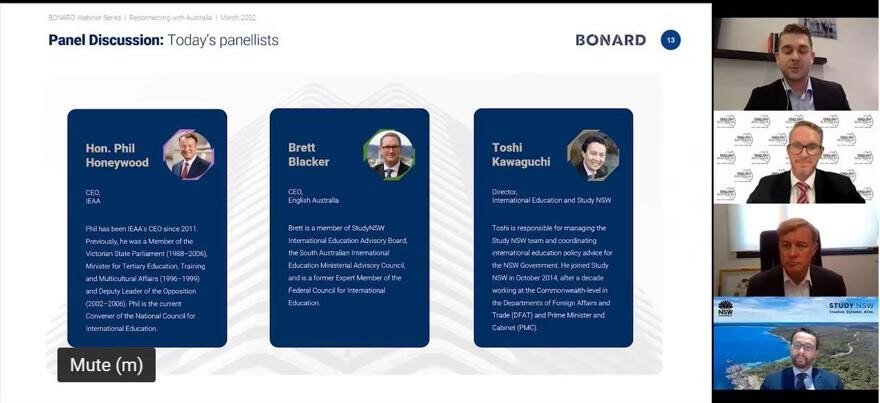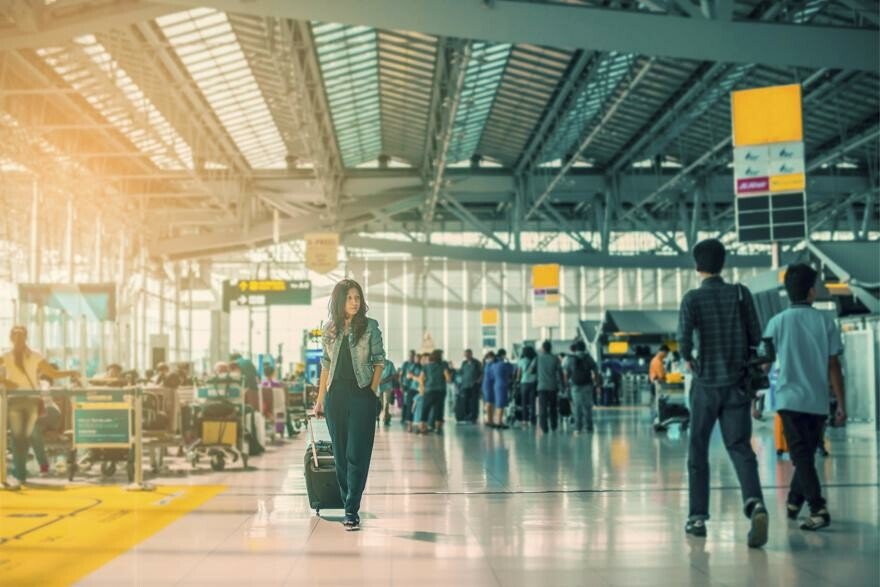The special Reconnecting with Australia: Engagement Strategies Post-Border Reopening webinar was hosted by research company BONARD with representatives from the International Education Association of Australia (IEAA), English Australia and Study NSW.
During the session, panellists discussed initiatives to boost student recruitment and return, a positive change in the legislative environment for international education, the importance of agencies in supporting those initiatives, and preliminary data insights since Australia reopened to students on December 15th.
Outlining some of the government-led moves to support the return of international students, Phil Honeywood, CEO of IEAA, said, “It’s a really exciting time.” He listed visa rebates for student and working holiday visa holders and a temporary lifting of work limits as particularly important. “We’ve gone from Fortress Australia to government policy being very supportive,” he said.

Panellists at the event.
He acknowledged that commercial flight capacity remains an issue to address, and cautioned that Australia’s largest source country, China, is faced with travel barriers and hesitancy, but said that students from India and Nepal are “jumping on planes”.
Brett Blacker, CEO of English Australia, the peak body for ELICOS English language providers, said that there were positive signs in visa applications and grants at the end of last year following Australia’s reopening to international students, but cautioned that ELICOS visas are still well down on 2019 levels and that there may be a lag before new students begin to arrive.
“We are very positive on market cultivation. Providers are working with agents to get the message out on reopening,” he said.
Toshi Kawaguchi, Director of International Education and Study NSW, said that New South Wales had managed to get some students in before the wider border reopening through an approved pilot scheme, and was now leading the country with 23,000 student arrivals between mid-December and February 21st.
“We are heavily investing in programmes that support students,” he said, with the aim that student support is “of the highest calibre”.
Speaking on the importance of agencies, Brett said, “Our agents are a critical part of the pipeline. We have to be really critical in close relations, and working with quality agents is paramount.” He urged against a rush to push commissions higher, a trend that he said could damage the sector in the longer term, and said schools and agents need “close one-to-one relationships that are respectful and beneficial”.
Toshi appealed to agents to help to spread the message of the investments that Study NSW has made and the support that is available to students. “Everything we do is free for students and designed to support safety, wellbeing and the overall experience in NSW.”
Toshi said that the NSW government unveiled a new recovery strategy for the sector and an investment of AUS$19.1 million over the next four years, built around four pillars: student returns; promotion and marketing; student experience; and ecosystem development.
He said that the factors that made Australia such a pre-pandemic success in international student recruitment, including quality of education, lifestyle and work opportunities, were still present.

International students have been allowed into Australia since December 15th.
Phil highlighted federal government measures to support the international education sector, including a recent package of AUS$10 million to support six initiatives; a sector consultation on international student diversity in higher education; and a forthcoming review of the ESOS Act, which informs quality standards in the sector.
Every state government now has welcome desks at their international airports, he said, staffed by student volunteers to welcome newly arriving students and assist with any questions.
He added that greater understanding among domestic students of the issues and challenges that international students face – as revealed in IEAA’s Student Voices research – had been a positive outcome of the pandemic.
Expected growth in ELICOS students Q1 to Q2. Source - BONARD/English Australia, Quarterly ELICOS Market Insight Q4 2021
“The wider community now understand the importance of international students far more than they ever did before,” he added.
In a data session prior to the event, Svetlana Cruz, Senior Research Manager at BONARD, highlighted that Australia was second in global ELT market share in 2019 prior to the Covid-19 pandemic, and highlighted the estimated AUS$2.7 billion loss to the ELICOS directly and other sectors indirectly from the loss of English language students.
She highlighted that colleges in the quarterly ELICOS surveys commissioned by English Australia expect a 16 per cent growth in students from Q1 2022 to Q2 2022, and said that all surveyed institutions expect to hire staff in coming months, with a third (33 per cent) expecting to hire seven or more new employees.






